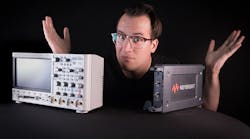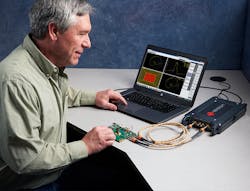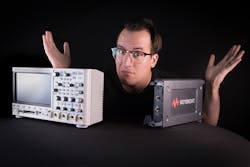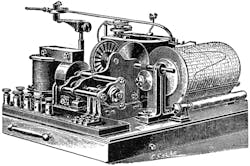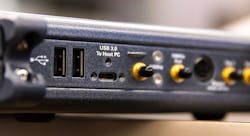The world will tell you that when it comes to test gear, USB equipment is in a different class than benchtop equipment. It’s not as good. It’s a pretty convenient line to draw—the form factor typically implies certain functionality. However, just like the five-second rule for dropping food on the floor, just because the rule is convenient, doesn’t mean it’s true. I’m all for eating floor-food, but I’m a little more cautious when it comes to making test gear decisions.
A USB vector network analyzer.
The old days where you would consider only one form factor have passed. Why? Designs have changed. The perks and techniques from traditional benchtop equipment are starting to get integrated into benchtop equipment. Plus, the strengths of benchtop equipment have started to move into USB equipment.
Using oscilloscopes as an example, let’s look at how the classic USB oscilloscope vs. benchtop oscilloscope debate holds up in 2018. Even though we’re going to look at oscilloscopes, the same philosophies apply to a lot of other types of equipment. Recent years have seen a big growth in USB power supplies, DMMs, and even network analyzers.
The USB Oscilloscope vs. Benchtop Oscilloscope Debate
Why the debate? After all, an oscilloscope is essentially just three parts: front-end conditioning circuitry, an analog-to-digital converter (ADC), and a processor. A similarly naïve assumption can be made for pretty much every other piece of test equipment.
A benchtop or USB oscilloscope?
But, anyone who’s ever used an oscilloscope will tell you that it’s so much more. Engineers have a special respect for oscilloscopes, almost a reverence. The little things matter.
I can’t tell you how many discussions I’ve overheard, or forum threads I’ve read, that talk about the feel of the knob detents and the satisfying snappiness of the UI. That’s why this division between the USB and benchtop camps is such a big issue. This equipment is precious and used regularly, so form factor has a big impact on daily life.
Full disclosure: I work for Keysight, and we make awesome test gear. This isn’t a sales pitch to get you to buy more Keysight, though; it’s a genuine attempt to clear up some of the confusion in the USB vs. benchtop debate. We’re also not paying anyone to publish this. However, feel free to buy all of the Keysight gear you want!
The Perks of Benchtop Oscilloscopes
I’ll be quick with this section because, let’s be honest, if you’re reading this article you probably already know what a benchtop oscilloscope is and does.
Benchtop oscilloscopes have been around as long as oscilloscopes have been around. Really. The first oscillograph (an oscilloscope forerunner) was basically a benchtop oscilloscope.
An oscillograph, the precursor of the oscilloscope. (Image source: https://en.wikipedia.org/wiki/File:Hospitalier_Ondograph.png)
Benchtop oscilloscopes have built-in everything. There’s a dedicated display, an embedded processor, front-panel control knobs/buttons, and a GUI that’s both functional and relatively un-modifiable. You generally don’t need to do any coding or hook up to a PC to get the data you want. If you have power and a probe, you can do at least 95% of what that oscilloscope is capable of performing. The same is true for other pieces of benchtop equipment.
Such capabilities bring you a few key things.
First, they’re darn simple to use. Because the built-in GUI is the main method of controlling the scope, it’s (usually) pretty bug-free, intuitive, and fully capable. You can grab it out of your neighbor’s cubicle, turn it on, and get started. That’s what it’s built for.
Second, benchtop oscilloscopes are generally higher performing. While size is always a concern for equipment, there’s a somewhat relaxed space expectation for benchtop oscilloscopes. Because benchtop oscilloscopes are “allowed” to be bigger, the manufacturers can build-in more capabilities.
Higher bandwidth, lower noise, refined processing, and snappy responsiveness are all classic advantages of benchtop oscilloscopes. Be warned, though, a lot of budget-level benchtop equipment is known to be buggy and not as responsive as their higher-priced counterparts. So, do your research before buying!
A dedicated start-at-boot UI is also common among lower bandwidth benchtop oscilloscopes (<1 GHz), while higher-end scopes almost exclusively run as a Windows application. This complicates the UI, but due to integrated hardware it doesn’t degrade oscilloscope performance.
Benchtop equipment tends to be the tool of choice due to its convenience and performance. USB oscilloscopes, though, have their own advantages.
Why People Rave About USB Oscilloscopes
Historically, USB oscilloscopes are known as the tool of broke engineering students and garage tinkerers. Like a benchtop oscilloscope, a USB oscilloscope has a front end and an ADC. However, it outsources the processing to a host PC.
There are two key benefits of USB oscilloscopes: bench space and cost.
If you’re doing electronics work, you probably have a pretty capable PC on your bench. Why waste bench space on a display and what’s essentially another PC when you can use the one you already have? This can save you valuable bench real estate for crowded work areas.
USB oscilloscopes also don’t have a display, which makes them significantly smaller. And, there’s no control hardware (knobs and buttons). With these two things absent, they are much, much smaller than benchtop oscilloscopes.
The size is also super convenient if you work in more than one physical location. USB oscilloscopes can be tossed into a backpack and set up wherever. Typically, you’re already carrying a laptop or going somewhere that has a PC, so the only extra weight is the scope. I don’t think I’ve ever tossed a benchtop oscilloscope into my backpack!
4. We had to break out the big backpack for a 6000 X-Series benchtop scope, but the USB version fits in Matt’s work bag.
The cost to build a USB oscilloscope is much lower, too, so they tend to be priced lower than benchtop oscilloscopes. After all, the manufacturer doesn’t need a display, control hardware, or a processor/motherboard. At Keysight, I get to look behind the curtain and see what these parts cost in benchtop gear, and I can tell you costs aren’t insignificant.
There is a downside—the low-cost nature of USB oscilloscopes has given the form factor a bad rap. For a while, it was probably deserved. Here’s why.
Why Do People Hate on USB Oscilloscopes?
I said earlier that USB oscilloscopes are known as the tool of broke engineering students and garage tinkerers. Why?
Cost and throughput.
Cost
In the past, USB oscilloscopes were not only low cost, but they were cheap. No engineer in their right mind would have bought a USB oscilloscope instead of a benchtop oscilloscope. The GUIs had a poor UX—they were buggy and slow. Because only the most cash-strapped buyers were considering USB oscilloscopes, manufacturers had to cut costs at every corner.
This meant cheaper components, fast software development times, marginal performance, and limited quality assurance. But, buyers knew what they were getting into. They were willing to put up with a subpar user experience to save money.
Throughput
Think about it, all of the data captured by a USB oscilloscope must be transferred over a USB cable. Sure, USB data rates are getting darn fast, but oscilloscopes need to dump a LOT of data. In lieu of transferring raw data, USB oscilloscopes can pre-process as much as possible. But, that adds cost and requires a lot more design work than just letting the PC do the heavy lifting.
Historically, the pressures of cost have overtaken the pressures of throughput. You’d be hard-pressed to find a USB oscilloscope with a waveform update rate rivaling that of a benchtop oscilloscope.
USB Oscilloscopes Don’t Have to be Bad
Despite the historical shortfalls, USB oscilloscopes are starting to become a viable option. There are two key trends driving this change.
First, USB oscilloscope companies are starting to refine their designs. USB oscilloscopes are a relatively new type of equipment. Accessible, capable computers are the backbone of USB scopes, so obviously, PC technology had to come first.
5. The USB host ports for a Keysight Streamline USB oscilloscope.
By contrast, oscilloscopes have been around for decades and decades, so there’s a lot more design experience. As designs improve, USB oscilloscope companies are starting to build small, but loyal, followings.
Second, benchtop oscilloscope manufacturers are starting to port their benchtop technology blocks into a USB form factor. For example, our latest USB oscilloscope uses the exact same front end, ADC, ASIC processor, and GUI as our benchtop InfiniiVision oscilloscopes. This means that you get the same design robustness as a benchtop oscilloscope without sacrificing quality.
Don’t Write Off USB-Based Test Equipment
Today, there’s a lot of bad equipment on the market. There’s some good gear, and a few pieces of great gear. This is true for both benchtop and USB form factors.
It’s crucial that you understand what to look for when picking out equipment. Don’t let the form factor fool you. Evaluate your needs, look at the critical specs, and read the forums to see what people are saying. Better yet, get your hands on a demo!
